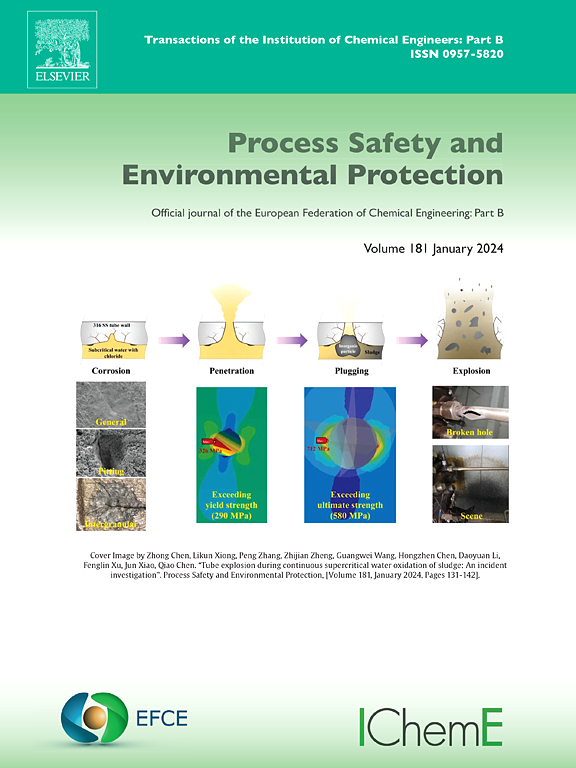Experimental study on the detonation characteristics in ammonia-hydrogen-air mixtures
IF 7.8
2区 环境科学与生态学
Q1 ENGINEERING, CHEMICAL
引用次数: 0
Abstract
This study experimentally investigates the detonation characteristics of ammonia-hydrogen-air mixtures containing ammonia proportions up to 25 percent, focusing on fuel composition and initial pressure effects on detonation velocity, peak pressure, cellular structure, and critical detonation pressure. A 5000 mm detonation tube equipped with pressure sensors and smoked-foil was employed to analyze wave propagation dynamics. Results demonstrate that increasing ammonia content reduces detonation stability, amplifies velocity fluctuations and cellular irregularity. Peak pressure shows positive correlation with initial pressure but diminishes at higher ammonia concentrations due to dilution effects. The critical detonation pressure systematically rises with ammonia content, driven by its chemical inhibition. A dimensionless parameter D/λ was proposed to characterize the detonation limits. Experimental results demonstrated that all tested premixed gases exhibited D/λ ratios exceeding unity, indicating that the tube dimensions satisfy the minimum requirement for sustaining stable multi-headed detonation structures. These findings offer critical insights for optimizing ammonia-hydrogen fuel blends in practical combustion systems while mitigating detonation hazards. The work establishes quantitative relationships between ammonia fraction, pressure conditions, and detonation behavior, providing essential data for safe implementation of ammonia-based alternative fuels.
氨-氢-空气混合物爆轰特性的实验研究
本研究通过实验研究了含氨比例高达25%的氨-氢-空气混合物的爆轰特性,重点研究了燃料成分和初始压力对爆轰速度、峰值压力、细胞结构和临界爆轰压力的影响。采用装有压力传感器和烟膜的5000 mm爆震管对波的传播动力学进行了分析。结果表明,氨含量的增加降低了爆轰稳定性,放大了速度波动和细胞不规则性。峰值压力与初始压力呈正相关,但在氨浓度较高时由于稀释效应而减小。在氨的化学抑制作用下,临界爆轰压力随氨含量的增加而系统地上升。提出了一个无量纲参数D/λ来表征爆轰极限。实验结果表明,所有被测的预混气体的D/λ比均大于1,表明管尺寸满足维持多头爆轰结构稳定的最小要求。这些发现为在实际燃烧系统中优化氨氢燃料混合物,同时减轻爆炸危险提供了重要的见解。这项工作建立了氨馏分、压力条件和爆轰行为之间的定量关系,为氨基替代燃料的安全实施提供了重要数据。
本文章由计算机程序翻译,如有差异,请以英文原文为准。
求助全文
约1分钟内获得全文
求助全文
来源期刊

Process Safety and Environmental Protection
环境科学-工程:化工
CiteScore
11.40
自引率
15.40%
发文量
929
审稿时长
8.0 months
期刊介绍:
The Process Safety and Environmental Protection (PSEP) journal is a leading international publication that focuses on the publication of high-quality, original research papers in the field of engineering, specifically those related to the safety of industrial processes and environmental protection. The journal encourages submissions that present new developments in safety and environmental aspects, particularly those that show how research findings can be applied in process engineering design and practice.
PSEP is particularly interested in research that brings fresh perspectives to established engineering principles, identifies unsolved problems, or suggests directions for future research. The journal also values contributions that push the boundaries of traditional engineering and welcomes multidisciplinary papers.
PSEP's articles are abstracted and indexed by a range of databases and services, which helps to ensure that the journal's research is accessible and recognized in the academic and professional communities. These databases include ANTE, Chemical Abstracts, Chemical Hazards in Industry, Current Contents, Elsevier Engineering Information database, Pascal Francis, Web of Science, Scopus, Engineering Information Database EnCompass LIT (Elsevier), and INSPEC. This wide coverage facilitates the dissemination of the journal's content to a global audience interested in process safety and environmental engineering.
 求助内容:
求助内容: 应助结果提醒方式:
应助结果提醒方式:


